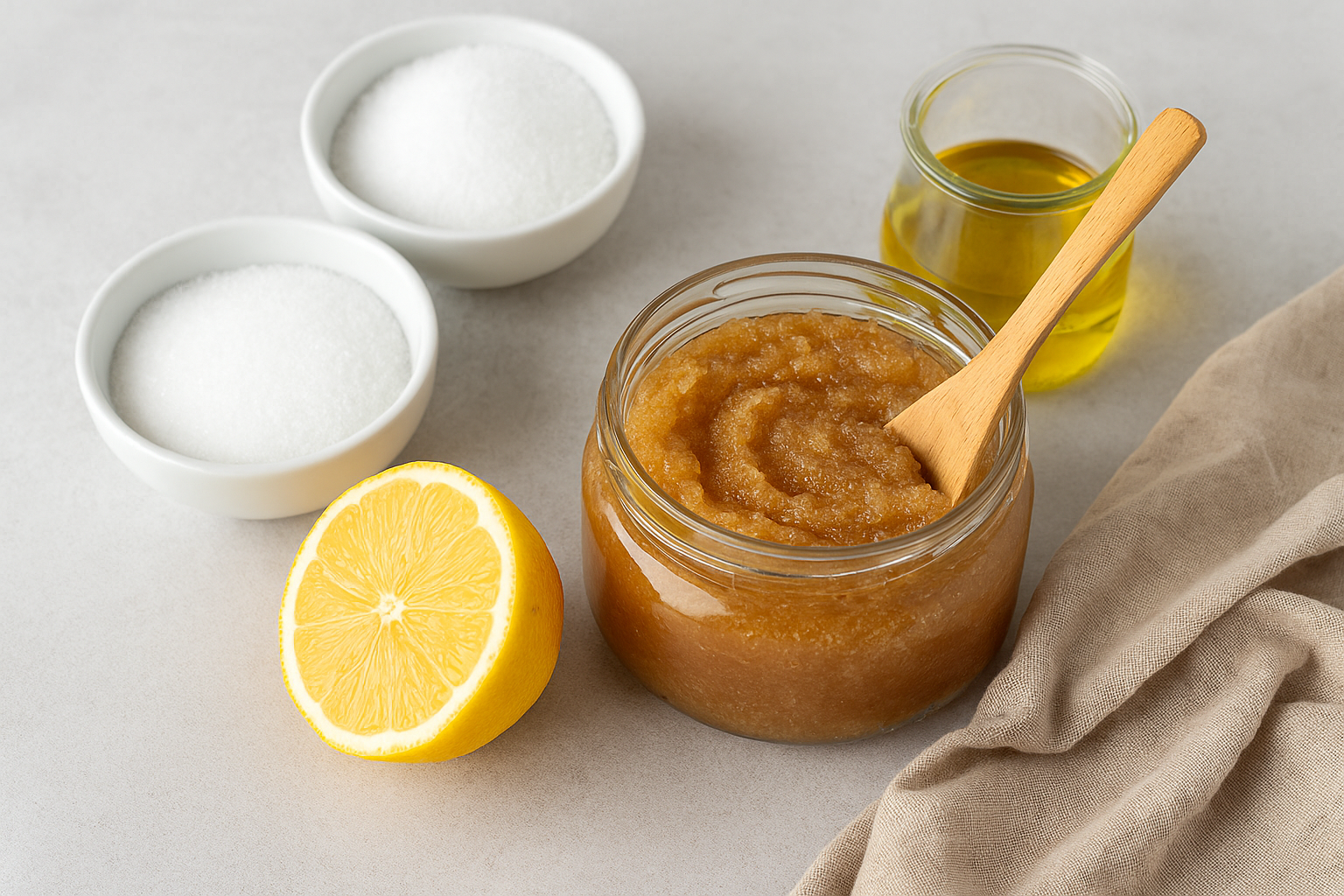Body scrubs are one of the easiest and most effective ways to refresh the skin. They remove dead cells, stimulate circulation, and leave the body soft and glowing.
Most scrubs sold in stores contain synthetic fragrances, preservatives, and even microplastics that harm the environment.
The good news is that you don’t need them. With simple ingredients already in your kitchen, you can prepare natural body scrubs that work just as well—if not better.
DIY natural body scrubs are customizable, inexpensive, and eco-friendly. You control the texture, fragrance, and strength.
Whether you want a gentle exfoliant for sensitive skin, a refreshing blend for summer, or a nourishing scrub for dry winter skin, there is a recipe that fits. This article explains how scrubs work, the best ingredients to use, and provides detailed recipes for face, body, and feet.
Why body scrubs matter
The skin naturally renews itself, but dead cells often build up, leading to dullness, clogged pores, and uneven texture.
Exfoliation helps remove this layer, allowing moisturizers to penetrate more effectively. Regular scrubbing also stimulates blood flow, giving the skin a natural glow.
Unlike chemical exfoliants, natural scrubs rely on physical exfoliation with sugar, salt, oats, or coffee grounds. When combined with oils and natural scents, they turn skincare into a relaxing ritual.
Benefits of homemade scrubs
They are safer, avoiding synthetic fragrances and parabens. They cost very little compared to spa treatments. They can be adjusted for skin type by choosing finer or coarser textures. They reduce waste by using ingredients that might otherwise be discarded, like coffee grounds or citrus peels. They are also fun to prepare, transforming skincare into a creative process.
Key ingredients and their functions
Exfoliants
- Sugar: gentle and dissolves slowly, ideal for face and body.
- Salt: coarser, best for feet and elbows.
- Coffee grounds: reduce puffiness and improve circulation.
- Oats: soft and soothing, excellent for sensitive skin.
- Rice flour: fine texture, brightens skin tone.
Carriers
- Coconut oil: moisturizes deeply, antibacterial.
- Olive oil: rich in vitamins, nourishes dry skin.
- Almond oil: light and easily absorbed.
- Honey: antibacterial and hydrating.
Scents and boosters
- Citrus peels: brighten and refresh.
- Rosemary: stimulates circulation.
- Marcela: calms and soothes.
- Lavender: reduces stress.
- Peppermint: cooling effect.
Basic formula for scrubs
1 part exfoliant + ½ part carrier oil + 5–10 drops essential oil. Mix until texture is consistent. Store in airtight jar for up to 2 weeks.
Recipes for face scrubs
Gentle Oat Scrub
- 2 tbsp ground oats
- 1 tbsp honey
- 1 tsp olive oil
Calms sensitive skin and removes impurities.
Brightening Rice Scrub
- 2 tbsp rice flour
- 1 tbsp yogurt
- 1 tsp lemon juice
Lightens dull skin and refreshes tone.
Coffee Wake-Up Scrub
- 1 tbsp fine coffee grounds
- 1 tsp honey
- 1 tsp coconut oil
Gently exfoliates and reduces puffiness.
Recipes for body scrubs
Citrus Sugar Scrub
- ½ cup sugar
- ¼ cup coconut oil
- Zest of 1 orange
- 6 drops orange oil
Leaves skin glowing and fragrant.
Rosemary Salt Scrub
- ½ cup sea salt
- ¼ cup olive oil
- 8 drops rosemary oil
- 1 tsp dried rosemary
Stimulates circulation and cleans deeply.
Marcela Relaxing Scrub
- ½ cup sugar
- ¼ cup almond oil
- 8 drops marcela oil
- 4 drops lavender oil
Calms mind and body while exfoliating.
Recipes for foot scrubs
Cooling Peppermint Scrub
- ½ cup salt
- ¼ cup coconut oil
- 6 drops peppermint oil
- 2 drops lemon oil
Refreshes tired feet and softens calluses.
Coffee Foot Energizer
- ½ cup coarse coffee grounds
- ¼ cup olive oil
- 6 drops rosemary oil
Stimulates blood flow and smooths heels.
Lemon Salt Scrub
- ½ cup sea salt
- ¼ cup almond oil
- Zest of 1 lemon
Brightens and deodorizes feet.
How to use scrubs correctly
Apply on damp skin in circular motions. For face, scrub gently for 1–2 minutes. For body, focus on elbows, knees, and dry areas. For feet, massage heels and soles for 3–4 minutes. Rinse with warm water and apply moisturizer after. Use 1–2 times per week.
Safety tips
Avoid scrubs on broken or irritated skin. Test oils on a small patch before use. Use fine textures for face and coarse ones only for body or feet. Do not store scrubs with fresh fruit for more than a few days. Always use clean spoons to avoid contamination.
Cultural roots of scrubs
Exfoliation rituals are ancient. In Gaúcho homes, natural ingredients like cornmeal, sugar, and herbs were used to polish skin after long days in the fields. Marcela teas doubled as rinses to calm irritation. Rosemary and citrus were rubbed on skin for freshness. By reviving these methods, DIY scrubs connect modern beauty with cultural tradition.
Mistakes to avoid
Do not add too much oil, or the scrub will be greasy. Do not make very large batches; small jars keep fresher. Do not expect scrubs to replace moisturizers; they work best as a complement. Do not overuse them, as daily scrubbing may irritate skin.
Long-term benefits
Regular use of natural scrubs smooths skin, prevents ingrown hairs, and improves circulation. It also creates rituals of self-care. Preparing scrubs at home adds creativity and reconnects families with natural ingredients. Over time, these habits reduce reliance on industrial cosmetics and build healthier lifestyles.
Conclusion
Homemade body scrubs made from kitchen ingredients are effective, safe, and enjoyable. They transform everyday items like sugar, salt, oats, and coffee into powerful skincare tools.
With oils and herbs, they become more than exfoliants—they are rituals of relaxation, focus, and cultural continuity.
By making your own scrubs, you protect your skin, save money, and reduce environmental impact. Every jar is proof that beauty and tradition can meet in simple, natural ways.

Marcela Cardozo is passionate about Southern Brazilian traditions and the cultural stories carried through natural scents. She blends knowledge of native herbs, essential oils, and regional rituals to create practical and inspiring content. Her writing connects ancestral wisdom with modern living, offering readers simple ways to bring authenticity, well-being, and meaning into their everyday lives.
